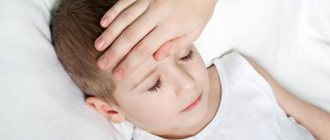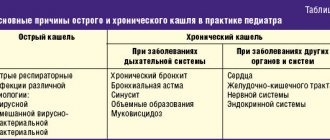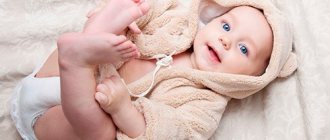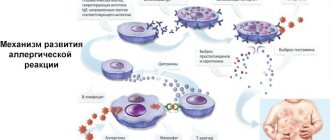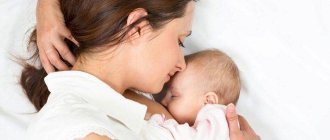Atopic dermatitis in children is a chronic inflammatory disease of an allergic nature. This type of dermatitis affects about 25% of all children in the world. The disease causes inconvenience not only to children, but also to adults. Indeed, with atopic diathesis, the child’s parents live in constant tension, all the time waiting for a new attack of the disease. If atopic dermatitis is not cured in time, then in the future the manifestations of allergies will become more severe. Sometimes it happens that during the first manifestations of dermatitis in an infant, parents do not consult a doctor. In this case, the manifestations of the disease subside, but at the age of 5-7 years they return and complications of atopic dermatitis may appear in the form of bronchial asthma or a more severe form of allergy.
Manifestation of atopic diathesis in a child on the cheeks
Causes of atopic dermatitis in children
There is no consensus or unified theory regarding how and for what reasons atopic dermatitis develops in children.
There are several versions in medical science, each of which has followers and opponents:
- Theory of allergic reaction or allergic genesis. Links autoimmune processes with increased susceptibility of the body to certain substances. Infants and young children are most susceptible to food allergens. As a result, the concentration of IgE antibodies in the serum sharply increases, provoking autoimmune phenomena.
- Hereditary theory. In fact, the hereditary nature of the disease has been confirmed. But neither the type of inheritance nor the level of genetic predisposition has yet been established. If one parent in a family suffers from AD, 30 out of 100 children will inherit the disease. But if atypical dermatitis is detected in both parents, then 75 out of 100 children will show signs of pathology 2 months after birth.
- Theory of cellular immunity disorder. Cellular immunity protects the body from infected cells. The whole process is carried out with the help of macrophages, T-lymphocytes, phagocytes, cells capable of capturing and digesting foreign particles. Failure of intracellular immunity leads to systemic diseases, psoriasis and AD. Autoimmune aggression provokes skin inflammation.
Homeopathic approach
Some parents believe that homeopathy is the safest treatment option for atopic dermatitis. In this case, treatment requires a comprehensive approach, so consulting a homeopath would not hurt. However, parents should be patient if they want to cure their child exclusively with the help of homeopathy.
Things to know:
- Treatment of atopic dermatitis with homeopathy will definitely take a long time; it can last from six months to several years.
- When treating with homeopathy, you must strictly follow all the doctor’s recommendations.
- Before going to a homeopathic doctor, you need to collect all the information about the child’s life. Including whether he suffered psychological trauma, what his mental state is at the moment. Physical and mental complaints should be described in detail.
- Usually a homeopath prescribes one remedy.
Sometimes a mother has a question about what diet she needs for atopic dermatitis in her baby. In such a situation, it is difficult to determine the source of the allergic rash in the baby, therefore, first of all, it is necessary to exclude from the mother’s diet all foods that are common allergens. These include honey, nuts, all red fruits and vegetables, citrus fruits and chocolate. You should also not drink more than a glass of cow's milk per day, since the protein contained in it is also a strong allergen for the baby.
Provoking factors
The severity of the disease and its clinical picture are directly related to the presence or absence of a provoking factor. Often this factor becomes an obstacle to remissions.
The following are considered as “emissaries” of the AD development mechanism:
- Unfavorable ecological climate of the region.
- Non-compliance with diet. When overfeeding, a child receives more protein than he needs. The enzyme system cannot cope with large amounts of food. “Good” turns into “harmful”, processed products are converted into toxins. In this case, it is not the protein itself that becomes the allergen, but its high quantity.
- Non-compliance with the mother's diet during pregnancy, alcohol consumption, smoking.
- Pathologies of pregnancy.
- Transferring the baby to artificial feeding too early. In the first months of life, the child’s body does not yet produce its own globulins. They pass to him through breast milk, providing an immune barrier. Switching to artificial feeding weakens the immune system, which is not yet fully formed, opens access to infections, increasing the risk of developing AD.
- Conditions of deficiency and lack of vitamins, polyunsaturated fatty acids, microelements.
- Helminthiases. Helminths and their metabolic products affect the mucous membrane and walls of the gastrointestinal tract, releasing toxins into the child’s blood that trigger immune and allergic processes.
- Gastrointestinal diseases. A healthy digestive system not only allows you to absorb food, but also acts as a barrier to infection. Gastrointestinal diseases affect the immune system and provoke the development of food allergies. In 90% of children diagnosed with atopic dermatitis, abnormalities in the functioning of the digestive system are also observed.
- Instability of the autonomic nervous system. The stability and stability of the autonomic nervous system ensures the coordinated functioning of internal organs and systems. Thanks to her, the child responds adequately to stress. In children with autonomic lability, cases of atopic dermatitis are more common and the severity of symptoms is stronger.
Classification and stages of development of atopic dermatitis in children
There are discussions in medicine about how and by what criteria to classify atopic dermatitis in children. This is due to the paradox of the process: vivid clinical expressions are not confirmed by increased IgE content, and there are no signs of sensitization. In medicine, a working classification has been adopted, consisting of several assessment groups.
According to clinical and morphological variants:
- exudative form,
- scaly form,
- mixed form,
- lichenoid form.
By stages of development:
- “Debut”, initial. The “onset” of the disease manifests itself in overweight and “overfed” children. The cheeks and buttocks turn red, the skin becomes dry, and slight peeling is observed.
- Stage of the expressed clinical picture. Spicy. It is characterized by total redness of the skin, extensive erythematous spots, the appearance of ulcers and blisters filled with protein fluid and blood. The itching intensifies and becomes constant, reaching its climax at night and depriving the child of sleep. The skin is dry, flaky, covered with crusts. Scratching appears on the skin with the formation of scars. Subacute. The itching subsides, the skin is extremely dry, flaky, and crusty. The skin in the affected areas thickens, its pattern changes, folds appear on the lower eyelid, and characteristic “jams” appear in the corners of the mouth.
- Remission stage. In incomplete remission, there is a partial absence of symptoms. With complete remission, clinical manifestations disappear for a period of 3 to 7 years.
By age phase:
- infant,
- children's,
- teenage-adult.
By area of distribution:
- predominant localization in one or several zones (limited),
- affected areas occupy large areas (widespread),
- the dermatological process covers the entire body, the palms and nasolabial triangle (diffuse) remain clean.
By severity:
- mild, erythema and peeling are insignificant, rashes are sporadic, lymph nodes are enlarged to the size of a medium-sized pea,
- moderate, the skin is thickened, weeping areas appear, itching is mild and moderate to severe, the process recurs every 3 months, remission lasts up to 4 months, lymph nodes reach the size of a hazelnut,
- severe, the lesions will spread throughout the body, the dermis cracks, erosions appear, the itching is persistent, severe, the lymph nodes are the size of a walnut, exacerbations every 1.5-2 months, there are no remissions.
According to the type of sensitivity of the body:
- food, when allergens are food products,
- polyvalent - “allergic to everything”, the body reacts to house dust, medicines, clothing fabric, hygiene products.
Stages
During atopic dermatitis in children, several stages are distinguished.
- Primary contact with an allergen – the immune system is activated.
- The initial stage is the appearance of the first symptoms.
- The stage of pronounced changes is the development of specific symptoms.
- Remission stage - occurs after therapy, there is a gradual attenuation of symptoms. Until the next exacerbation, the disease is asymptomatic.
- The stage of clinical recovery is complete recovery from the disease; after contact with the allergen, the inflammatory process does not develop.
The duration of each stage depends on the severity of the pathological process and timely treatment.
Main symptoms and signs
The clinical picture depends on the age of the child, the stage and degree of AD, and the prevalence of inflammation.
| Symptom | Clinical manifestations |
| Erythema (redness of the skin) | The skin turns red and the network of capillaries is clearly visible. |
| Itching | At all stages and regardless of age, the child is accompanied by AD. The child scratches the itchy areas, injuring the skin. Bleeding abrasions and scratches appear. |
| Rashes | Diverse in type (crusts, pustules, papules, plaques). Located throughout the body. “Favorite” places of localization are the buttocks, the back of the neck, the face, and the back. |
| Lichenification | The skin becomes rough and covered with thin, small-plate scales. Normal skin grooves deepen. |
| Nervous system malfunctions | It manifests itself as anxiety, irritability, turning into aggression, and sleep disturbances. |
| High immunoglobulin E content | The immunoglobulin content in AD sometimes exceeds the maximum permissible norm by 10 times. |
Classification
Neurodermatitis in children is classified into several forms, depending on age and severity. Highlight:
- Acute atopy - manifested by edema, spots, erythema, vesicles and papules.
- Subacute form – crusts and peeling appear on the skin.
- Chronic dermatitis - peeling is quite pronounced, accompanied by pigmentation.
Classification of atopic dermatitis depending on age:
- Infant form – in children under 3 years of age.
- Children's uniform - 3-12 years.
- Teenage form – 12-18 years.
- Adult form – after 18 years.
Stages of atopic dermatitis in children:
- Initial – characterized by swelling, redness and peeling of the cheeks. With timely initiation of therapy and adherence to diet, the disease at this stage is reversible.
- Severe – occurs both acutely and chronically. In the acute phase, microbubbles appear that are prone to rupture with the formation of crusts. In chronic cases, symptoms may disappear completely.
- Remission - manifestations of atopy are mild or absent. Remission can last up to several years.
- Clinical recovery – it is said to be the absence of symptoms for 3-7 years.
Change in general state by phases
Depending on age, there are three phases of atopic dermatitis. All of them, to a greater or lesser extent, are accompanied by itching, pain, and skin rashes.
- Initial (infantile) phase. The first symptoms appear 2-6 months after birth. Skin inflammatory processes in infancy are specific. The clinical pictures of the disease in an infant and a one-year-old child are different. The forehead and cheeks are covered with erythematous spots. Plaques, diaper rash, and swelling appear on the neck and face. The initial area of the rash is the forehead and cheeks, then the process spreads to the shoulders, back, buttocks, and the outer part of the legs. The nasolabial triangle remains a rash-free area on the face. In infants, atypical dermatitis manifests itself in two types - seborrheic and nummular. With seborrheic dermatitis, the head, eyebrows, and back of the neck are covered with gneisses or milky scabs, yellowish-brown fatty scales. At the same time, small, bleeding, poorly healing wounds appear in the skin folds. Seborrheic dermatitis has a second name - skin fold dermatitis. When AD is combined with an infection, the skin becomes covered with a small, scaly rash that covers either large areas or the entire body. At the same time, chills appear, the temperature rises, and the lymph nodes enlarge. Nummular dermatitis is less common in children. Characterized by profuse rashes on the neck and face. Individual fragments of rashes merge and, occupying larger areas, form a single spot.
- Childhood phase. Lasts from one to 8 years. In the childhood phase, inflammatory processes in the dermis become chronic. In a child, the process of keratinization of the epithelium is disrupted, which slows down the process of rejection of cells of the stratum corneum. The palms and soles become covered with cracks, the skin becomes rough and loses elasticity.
- Adolescent-adult phase. Occurs during puberty. Inflammatory processes in the dermis in adolescents become chronic. Foci of erythema acquire a pale pink color, papular rashes are localized on the neck, chest, elbow and knee bends. Cracks appear on the feet, the skin on them becomes rough and dry. Hair may partially fall out on the back of the head. With exacerbation, perioral dermatitis develops, the skin on the face becomes covered with blisters with purulent contents.
Complications
The main cause of complications with atopic dermatitis in children is constant scratching and trauma to the skin due to severe itching. This can lead to a secondary infection.
When the skin is bacterially infected, a child develops pyoderma, a purulent-inflammatory disease accompanied by pustular rashes on the body. At the same time, the child’s general well-being worsens and body temperature rises.
The causative agent of viral skin lesions is herpes simplex. Bubbles filled with liquid appear on the body. The affected area is the face and mucous membranes of the oropharynx and genitals.
When infected with yeast-like fungi, children develop thrush. Skin folds, hands, feet and scalp are affected. In most cases, there is a combination of bacterial and fungal infection.
Another common complication of the acute stage of atopic dermatitis is its transition to a chronic form. The progression of atopic dermatitis with frequent exacerbations increases the risk of developing bronchial asthma and other respiratory diseases.
Diagnosis of atopic dermatitis in children
Diagnostic measures for each child are selected individually, but a blood test - general and biochemical - is a necessary procedure.
General blood analysis
Allows you to see the overall picture of inflammation. This is a kind of beacon indicating the direction of subsequent actions.
To avoid obtaining distorted data, the examination is carried out on an empty stomach. The main criterion of the study is the determination of the number of eozonophilic granulocytes. A high number (more than 2%) indicates an allergic reaction or helminth infection. With atopic dermatitis, it is possible to increase the level of ESR, exceeding the maximum permissible content of leukocytes and basophils. Other indicators remain unchanged.
Blood chemistry
Allows you to diagnose the functioning of internal organs. The evaluation criteria are bilirubin indicators, protein fractions, and uric acid. The starting points for diagnosing AD are liver and kidney tests. Deviation of results indicates malfunctions in the functioning of these organs. Dysfunction of the kidneys and liver leads to the development of allergic processes.
Antibiotics should be discontinued before testing. During the day, all fatty, fried, spicy foods are excluded from the diet, physical activity and thermal procedures are canceled.
Quantitative determination of immunoglobulin E
Determines the quantitative content of immunoglobulin E, a protein compound in blood plasma. In children with AD, its content is always elevated. And during the acute course of the disease, the content of this specific allergy indicator in the blood serum exceeds the permissible norm several times.
Special allergy tests
Allergy tests are not carried out on very young children. Until 4-5 years of age, a child’s digestive system is imperfect; a reaction to the test can occur to all types of food products.
There are several types of tests:
- Application. Strips of a patch with the allergen applied are glued to the skin. The patch is worn continuously for 2 days.
- Tests on mucous membranes. The allergen is applied to the mucous membranes of the nose or eyes.
- Scarification tests. A tiny amount of allergen is applied to the skin, then an incision is made. A child should not make more than 2 incisions at a time.
- Prick test. The allergen is applied to the skin and subcutaneous punctures are made. Compared to scarification, this method is less painful. But scarification is certified in Russia and is used more often.
Among the advantages of the method, there is a higher accuracy in determining the allergen substance. Disadvantages include direct contact of the body with the allergen, discomfort during the prick test and scarification, and a limited number of allergens that are detected in one study.
Determination of specific antibodies
The material for the study is venous blood. The method allows you to determine specific compounds in the blood plasma that are formed in response to toxins, bacteria, viruses entering the body.
Specifically, antibodies are “guardians of the immune system”; they are sensitive to any irritating external invasion. This defense reaction allows you to quickly identify the “aggressor”, remove it and relieve inflammation.
In the laboratory, a line of allergens that are similar in structure is determined. This way, both the main provocative factor and the allergens that cause a cross-reaction are identified.
Principles of basic treatment of AD in children
The basis of the treatment of atopic dermatitis on the “four pillars”:
- Reduction or complete elimination of itching and dermatic inflammatory processes.
- Restoring the structure of the dermis, normalizing its moisture and elasticity.
- Eliminating the return of the disease and its transition to severe forms.
- Treatment of associated and related processes.
These principles are relevant at all stages of the disease, but therapeutic measures during the acute course and remissions are different.
During an acute course
The first and main step during exacerbations is eliminating the provoking factor. Infants often develop contact forms of allergies, manifested by reactions to diapers, soft toys, and synthetic clothing. In such cases, it is enough to change the brand of diaper and switch to natural fabrics. What necessary measures are being considered:
- Symptomatic therapy. The pharmaceutical industry produces hormonal drugs in tablet form or in the form of injection solutions. Medicines of this kind are used as prescribed by a doctor. The starting point for the choice is the general condition of the child, the nature of the rashes, and the area they occupy.
- Elimination of systemic manifestations. In very severe cases of the disease, injections of hormonal antihistamines are prescribed.
- Diet. The period of exacerbation requires the most strict diet. The menu includes hypoallergenic cereals, lean meat, and sugar is replaced with fructose.
- Maintain personal hygiene. During exacerbations, the number of daily baths is reduced, and wet cleaning is carried out at least twice a day. One of the main conditions is cleaning and trimming the child’s nails. Long nails lead to scratching and scratching, while dirty nails lead to infection.
- Maintaining a daily routine. Creating a favorable psychological environment. During the day, the child should sleep 10-12 hours and be in a calm environment. Any psycho-emotional stress leads to an atopic march.
During remissions
During the lull, the use of drugs that have a regenerating and restorative effect continues. During this period, baths with infusions of medicinal herbs, herbal lotions and compresses are useful.
During remissions, the child is prescribed medications that support and strengthen the immune system. Control over the functioning of the gastrointestinal tract, liver, and kidneys does not cease. To normalize intestinal function in case of dysbacteriosis and disturbed microflora, the child is prescribed drugs rich in bifidobacteria and lactobacilli: “Acidolac baby”, “Bifiform baby”.
As one of the important conditions for prolonging remission, a diet compiled by an allergist is followed, excluding all allergenic foods.
Drug therapy
Treatment of atopic dermatitis is a complex, lengthy process that requires a systematic approach. For treatment, antihistamines, hormonal and non-hormonal creams, ointments, mash, emollients, infusions and herbal decoctions are used.
- Antihistamines. Available in the form of ointments, tablets, drops. Symptomatic therapy does not eliminate the causative factor, but reduces the production of histamine, eliminates itching, and relieves swelling.
- Corticosteroid hormones. Eliminate symptoms of the process. Prescribed for acute AD. Up to a year, hormonal drugs are used only in severe cases and as prescribed by a doctor.
- Local therapy agents. Remove itching, swelling, rashes. Regenerate and heal the skin, restore its moisture and elasticity.
- Vitamins. Accelerate regeneration processes, improve the structure and general condition of the skin.
- Antibiotics. Prescribed for associated infection; for AD in combination with a viral infection, antiviral drugs are prescribed.
- Sedatives. Prescribed to relieve irritation, aggression and sleep disorders.
Local therapy
In the case of severe atopic dermatitis, it can be cured only by applying ointments containing glucocorticosteroids to the affected areas of the skin.
The most commonly used hormonal ointments:
- Celestoderma, Cutiveita.
- Lokiod, Elokom.
A very important step during the treatment of atopic dermatitis in children is the selection of an ointment or mixture that has an antibacterial effect. Emollients are mainly used for atopic dermatitis. The moisturizing effect of these products allows the skin to restore its barrier function, which is very important for recovery. Emollients for atopic dermatitis in children should be chosen in the form of a cream - emulsion. A good choice would be La Roche-Posay. Bepanten helps with various forms of dermatitis. It can be used by adults and children. This ointment has proven itself well in the pharmaceutical market. Bepanten is simply an irreplaceable remedy for atopic dermatitis. The ointment stimulates skin regeneration, thereby accelerating the healing process. The product is non-toxic and can be used to treat children of any age. Another effective remedy for treating children from atopic dermatitis is lipicar balm, which has a lipid-restoring effect. Lipikar helps the skin restore its normal microbiome, thereby preventing relapses of the disease. The balm restores the protective properties of the skin, its barrier is renewed. The product also has anti-inflammatory, moisturizing and soothing effects. Mustela cream perfectly helps with atopic dermatitis in children, which perfectly moisturizes delicate children's skin, nourishes it and eliminates the symptoms of atopic dermatitis. Apply the cream 2 times a day to the skin of the face and body. A positive result will appear within three weeks. The most inexpensive and at the same time effective remedy for atopic dermatitis in children is tar soap. Already from the first bath, the roughness on the child’s atopic skin decreases. After swimming for 2 weeks, the rash usually goes away completely. This effect is due to the fact that tar soap improves blood supply to damaged areas of the skin, promotes cell renewal, relieves inflammation and has an antiseptic effect.
Possibilities of spa treatment
Sanatorium-resort treatment is recommended for children suffering from AD during remissions. For the treatment of a child, a resort with a familiar climate is selected. Trips to southern resorts are not always justified.
For a child’s body, a trip to another climate zone is always stressful. Acclimatization takes about 10 days. Travel for a period of a month or more can be considered rational. If you really want to be in the sun, choose children's sanatoriums in Kislovodsk, Crimea and Krasnodar Territory.
The entire range of procedures is provided by sanatoriums in the Sverdlovsk region (Lenevka), Perm region (Klyuchi), and Sol-Iletsk.
With the help of climatotherapy, mud therapy, radon and sulfide baths, it is possible to forget about relapses of the disease for several years.
Consequences and complications of atopic dermatitis in children
With adequate, timely treatment, there is a chance of avoiding consequences. Exacerbations and drug therapy with antibiotics and corticosteroids lead to complications of the process.
- Attachment of a bacterial infection. Itching is a constant companion of AD. When scratching itchy lesions, streptococcal and staphylococcal flora are introduced. Within a few hours after infection, the first symptoms of inflammation appear.
- Infection of erosions and weeping wounds. A tiny amount of the pathogen is enough for the development of viral and mycotic infections, requiring the prescription of antibiotics.
- Gastrointestinal dysfunctions. By destroying infectious agents, oral antibiotics also have a negative effect on the beneficial microflora of the gastrointestinal tract. The result is dysbiosis, constipation, indigestion.
- Atrophy of the skin. A common result of using antibacterial agents. There can be two options: the skin looks either very thin, or thick and rough, covered with crusts and scabs.
In severe cases, fungal, viral, and bacterial infections occur simultaneously. As a result, thrush develops, herpetic rashes, purulent and eczematous skin lesions appear.
In 80 children out of 100, an advanced atypical process leads to the development of bronchial asthma, Kaposi's eczema, stomatitis, and allergic rhinitis.
Prevention of AD
Primary prevention measures are aimed at preventing the disease; they begin during gestation. All aggressor foods are excluded from the diet of the expectant mother, gestosis is promptly prevented and treated, and the drug burden on the body is minimized. Secondary prevention is based on 4 criteria:
- Proper nutrition - eliminating all foods with a high degree of allergenicity and keeping a food diary.
- Skin care - using neutral bathing products, baby creams, emollients.
- Strengthening the immune system - hardening the child, taking vitamins, using foods with prebiotics.
- Stable psychological climate – maintaining the child’s nervous system in a calm state, reducing stress and psycho-emotional stress.
Despite possible complications, favorable resolution of the process is predicted in more than 50% of patients. In 1/3 of children, AD regresses and disappears by 18 months. The majority of patients experience complete remission by the age of 30.
The prognosis and quality of life of the patient depend on the knowledge gained about the causes of the disease, its development, symptoms, possible consequences, and on the implementation of all prescriptions and recommendations of the attending physician.
Causes of the disease
The main factor in the occurrence of childhood atopic dermatitis is hereditary predisposition. If a child has relatives suffering from bronchial asthma or various allergic diseases, then the likelihood of dermatitis increases by 50%. Often the cause of atopic diathesis in children is poor nutrition or poor skin care. Children's skin contains many lipids; it is very delicate and sensitive to the effects of adverse external factors. For example, poor hygiene or a large amount of dust in the house can trigger the development of a severe allergic reaction in the form of atopic dermatitis. The presence of pets in the house, frequent spraying of chemicals (air fresheners, hair sprays, etc.), excessive use of washing powder can also trigger allergies. If contact with the allergen is long enough, allergic manifestations develop faster.
Often a bacterial infection is associated with an allergy. This happens because the child scratches the damaged skin, resulting in wounds that can become infected. This can lead to the development of a secondary disease.
Main causes of the disease:
- Unsatisfactory environmental situation.
- Poor nutrition.
- Poor skin care.
- Wet cleaning is rarely done.
- Artificial feeding.
- Lack of vitamins.
- Presence of worms.
- Increased sweating.
- Features of the constitution.
- Frequent stress.
- Genetic predisposition.


